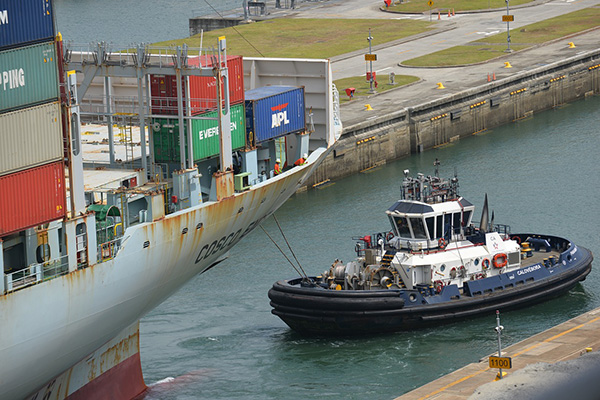Canal drought restrictions are easing, but manufacturers must prepare for the supply chain threats of more extreme weather.

By Eric Fullerton, Senior Director of Product Marketing at project44
Nearly a year has passed since severe drought in Panama led the Panama Canal Authority to implement capacity restrictions for vessels crossing the canal. While restrictions are now easing, canal operations still haven’t returned to full capacity – the daily transit limit increased to 31 vessels on May 16 (compared to 36 vessels prior to the drought). With increased rainfall forecasted, the Panama Canal Authority expects to return to 90% operating capacity in June. On top of this, restrictions on the maximum permitted draft will increase to 45 feet, up from the current limit of 44 feet. That means the worst of the Panama Canal disruptions may be over in time for this year’s peak shipping season, which kicks off in October.
Conditions in Panama may be improving, but the threat of extreme weather looms larger than ever. While El Niño exacerbated the drought in Panama last year, we’re now shifting to La Niña – making conditions ideal for hurricanes. Researchers at Colorado State University predict a record-breaking Atlantic hurricane season this year, with five “major” hurricanes. We can predict natural weather oscillations, though global climate change adds a wild card. As weather becomes more volatile, the frequency and intensity of storms and droughts continues to increase.
We’ll inevitably face more supply chain disruptions due to extreme weather and natural disasters, and manufacturers can’t afford to operate in reactive mode. Now is the time to apply lessons learned from the Panama Canal drought to build more agile, high-velocity supply chain operations that can weather the storm.
Here are two takeaways manufacturers should consider to get ahead of climate-related catastrophes.
Takeaway 1: Adopt More Sophisticated Inventory Management
Maintaining operational continuity in the face of supply chain disruptions is difficult, especially for industries like automotive, which rely on a lean, just-in-time inventory model. Simply tracking where a vessel or container is won’t equip you to effectively adjust inventory planning when disaster strikes. This siloed approach to visibility requires manual, error-prone calculations to deduce how one event impacts the health of your supply chain operations.
Instead, manufacturers should shift to real-time visibility that encompasses inventory in motion. The ability to quickly analyze inventory in transit compared to inventory at rest allows you to determine where stock will run out and where to reallocate from. For example, if a hurricane shuts down operations at a port for a week, an auto manufacturer with inventory visibility could see the amount of inventory that’s at risk of arriving seven days late to a plant where it doesn’t have seven days of safety stock padded. This more sophisticated approach to inventory management saves millions of dollars that would have been wasted on halted production lines, unnecessary air expedites or excess safety stock. Supply chain operations are both manufacturers’ biggest risk and biggest opportunity in terms of cost – so investing in inventory planning is where you can see the greatest ROI in an increasingly volatile world.
Takeaway 2: Strengthen Contingency Planning
Trade has become more globalized, and that means there are more vulnerabilities in supply chains. As we saw earlier this year with the Panama Canal drought and the Houthi attacks on commercial vessels near the Suez Canal, two critical supply chain lanes can be simultaneously restricted. While rerouting may seem like a solid plan B, it’s not always a viable option – manufacturers need to also have a Plan C and Plan D. And these alternatives come with tradeoffs, often in the form of increased costs or delays. For example, US manufacturers could avoid the Panama Canal bottleneck by shifting freight to West Coast ports instead of the East Coast. But, in recent years, the West Coast has seen higher rates of port congestion and labor strikes, so there are risks inherent in that alternative. Avoiding conflict is not always a possibility, and in some cases, isn’t financially prudent.
So, it’s critical that manufacturers engage in scenario planning and proactively develop contingency plans for potential supply chain risks. Risk management strategies should not only include mapping alternative routes, but also diversifying suppliers. These alternatives allow manufacturers to identify and reduce points of friction to achieve high-velocity supply chain operations. There are some black swan events that you simply can’t anticipate, so having agility baked into supply chain processes is essential.
Overall, the Panama Canal drought highlighted the importance of weighing climate risks in both supply chain infrastructure and operations. While the downstream effects of drought-related restrictions were felt gradually over the past year, manufacturers don’t always have the luxury of time with acute weather events like hurricanes. The way manufacturers respond in the first 24 hours of a catastrophe is crucial to preventing a ripple effect on inventory, schedule and costs. Now is the time to put a plan in place.

Eric Fullerton is senior director of product marketing at project44, with over 10 years of experience in software technology helping organizations adopt a digital-first approach. Fullerton has worked with Fortune 500 companies across multiple industries to navigate the divide between people, processes and technology, helping companies adopt digital transformation, aiming to increase efficiency, save costs and deliver superior customer experiences.
Scott Ellyson, CEO of East West Manufacturing, brings decades of global manufacturing and supply chain leadership to the conversation. In this episode, he shares practical insights on scaling operations, navigating complexity, and building resilient manufacturing networks in an increasingly connected world.